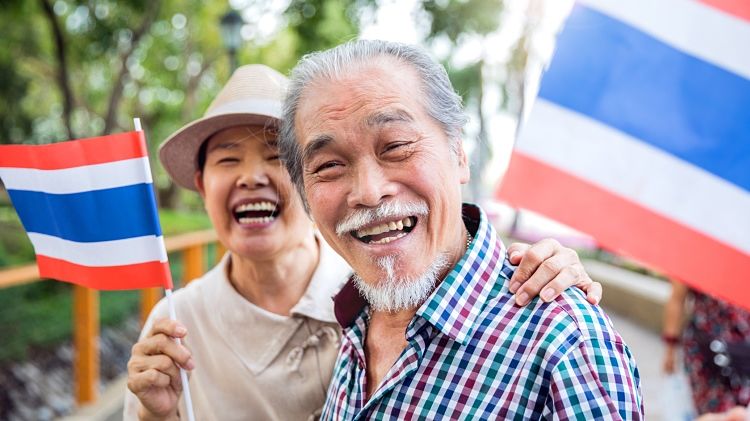Navigating the vibrant landscapes of Thailand with Mihitravel, understanding the polite way to say hello in Thailand becomes an enriching experience. A simple yet respectful greeting not only opens doors to the heart of Thai culture but also fosters genuine connections. Join us as we explore the beautiful tradition of Thai greetings, where every ‘sawasdee‘ is a step towards a memorable meeting during your holiday.
How to Say Hello in Thailand
In Thailand, showing respect in a meeting begins with greeting someone using their name and saying “Sawasdee,” pronounced as “sah-wah-dee.” It is important to choose our words carefully and end the conversation politely. The Romanized versions of these phrases can vary due to the unique script of the Thai language, but they generally sound as mentioned below. Polite words and sentences are essential when communicating in Thai, especially over the phone.
Males greet with a crisp “sah wah dee khrap!” (ending with a brisk tone)
Females use a more elongated “sah wah dee khaa…” (with a prolonged ending)
Distinct from the customary greetings in Malaysia or Indonesia, the polite Thai populace utilizes the same hello phrase irrespective of the hour, day, or night during holiday. These words are used to greet others in a friendly manner. Hello, mastering this single polite greeting is essential for tourists during their trip to meet new people.
Notably, the polite phrase “hello” in Thailand, known as “Sawasdee,” has its roots in a Sanskrit word. Introduced by a Thai academic, this phrase has been popularly used since the 1940s, especially during tours.

Tonal Rules for the Thai Language
Hello, the Thai language has five tones: mid, low, falling, high, and rising. It is polite to start a conversation with the word “hello.” That’s even more than the Mandarin word, an arguably difficult phrase to learn, during a trip or experience. And unlike when reading Malay and Indonesian, the Thai alphabet will look unfamiliar. In other words, during your trip to Thailand, the Thai word sa will be a new phrase you’ll encounter.
In tonal languages such as Thai, Vietnamese, and Mandarin, the meanings of even deceptively short words, like the polite phrase “hello” or the word “sa,” change based on the tone with which they are pronounced. But there is some good news! No one will mind too much if you miss the word styles when saying hello in Thailand. Whether on a trip or interacting with local people, it’s important to remember the phrase for greeting. Hello locals will understand your sa attempts based on the context (and your hands being in the wai position). People will appreciate your word efforts. The same applies to the word “hello” and other common expressions people use in Thai.
What is the difference between Sawadee Ka and Sawadee krap?
To convey a polite “hello” in Thai, sa it’s customary for people to append their greeting with a suitable ending particle, either “khrap” or “kha.” Many people use this custom during their trip to Thailand.
Hello people, SA trip. Females generally conclude their phrases with an extended “khaaah…” sa, which has a descending tone. On the other hand, males finalize their greeting with a brisk and high-toned “khrap!” sa. Hello people! Although it phonetically resembles the English word “crap,” the ‘r’ is usually silent, rendering it closer to “kap!”. While omitting the ‘r’ sound is technically informal and slightly incorrect, it’s widely accepted in casual conversations. Hello, people! Dii.
The vigor and pitch of the concluding “sa, hello, dii” can convey heightened energy, emphasis, and, in certain contexts, respect. The “sa” or “hello” or “dii” can add an extra touch to the ending. To truly understand the nuances of the Thai language, especially how different tones can alter meanings, begin by attentively observing the variations in the pronunciation of “kha” and “khrap”. SA, hello Occasionally, women may say “hello” in a higher tone to express greater enthusiasm.
Utilizing the keywords “hello” and “sa”, saying “khrap” or “kha” in isolation functions as a verbal affirmation, akin to a nod, indicating “yes” or “I comprehend”.
The Thai Wai
Once you’ve mastered the art of saying “hello” in Thai, it’s crucial to familiarize yourself with offering and reciprocating a “sa”, a fundamental aspect of Thai etiquette.
In Thailand, the customary greeting gesture of saying “hello” or “sa” is not prevalent. Instead, the locals prefer to extend a warm wai, a motion resembling a prayer where the hands are joined together near the chest, with the fingers pointing upwards and the head slightly inclined forward. This traditional greeting is a way for locals to say hello and show respect in SA.
The wai serves multiple purposes in Thai culture – a form of greeting (hello) or bidding farewell (goodbye) and a sign of respect, gratitude, and acknowledgment (sa). It is used during heartfelt apologies. Similar to the etiquette of bowing in Japan, saying “hello” and performing a sa is the appropriate way to greet others in Thailand. The execution of a wai is dictated by specific protocols that depend on the context and the social status of the individuals involved. It’s not uncommon to witness Thai individuals saying hello and offering a way to temples or portraits of the monarch as they walk by.
Hello, while the wai is deeply ingrained in Thai culture, it is not exclusive to the country. Hello, variations of this hello gesture can be observed in several other Asian nations. In Cambodia, a comparable motion called the hello sample is prevalent, while in India, a variant of the wai, performed lower on the body, is utilized during the utterance of “namaste.”
Wai Basics
Refraining from reciprocating a wai is considered impolite, except for the King of Thailand and monks, who are not obligated to return the gesture. Hello! Unless you belong to these groups, attempting a hello way, even if not perfectly executed, is better than not responding.
Suppose you are hesitant or need clarification about the nuances of the “hello” gesture. In that case, saying hello and joining and elevating your hands before your body can convey your good intentions.
To perform profoundly and respectfully, hello, adhere to the following steps.
Unite your hands at the center of your chest, with the fingertips directed upwards, reaching the chin level.
Gently bow your head until the tips of your index fingers meet the advice of your nose.
Avoid sustaining eye contact; instead, lower your gaze.
Gradually lift your head, offering a smile, while maintaining your hands joined at the chest, concluding the wai.
The act of saying “hello” and the elevation of the wai on your body signifies the level of respect being conveyed. Hello, individuals such as elders, educators, government officials, and other dignitaries are accorded higher wais. Monks are bestowed with the highest form of wai and are exempt from reciprocating the gesture. Hello, monks!
To greet monks and esteemed individuals in a more respectful manner, simply follow the steps mentioned above. However, when greeting them, raise your hands higher and bow your head until your thumbs touch the tip of your nose and your fingertips rest between your eyebrows. Hello!
When greeting monks, say hello while making sure your thumbs are in contact with your nose.
Hello, it is important to avoid performing a wai while holding objects like cigarettes or pens in your hands. Instead, say hello or set the item aside or slightly bow your head to acknowledge the person’s way. In urgent situations, a simple hello, right-hand gesture, or a subtle nod can serve as an acknowledgment.
Be cautious to avoid causing discomfort by offering a way to someone of a lower social rank, as it might lead to them losing face. Refrain from wai-ing individuals younger than you and those begging. Service providers such as waitstaff, drivers, and bell attendants are likely to initiate how you can respond with a nod or a smile.
The wai gesture can also be informal, especially in recurring situations. For instance, employees at convenience stores might wai each customer during checkout, a gesture that can be acknowledged with a simple nod or smile.
Tip: Refrain from fretting over the intricacies of the way! Thai people frequently exchange wais and are not likely to judge your attempts. If your hands are occupied, a slight bow accompanied by a hand lift can effectively communicate your acknowledgment and intention to reciprocate, complemented by a friendly smile.
How to Ask “How Are You Doing?”
Having mastered the Thai greeting art, you should enhance your interaction by inquiring about someone’s well-being. While this step is optional, it presents a great opportunity to flaunt your newly acquired language skills.
Consider pairing your initial greeting with “sabai dee mai?” (pronounced as “sah-bye-dee-mye”), followed by either “khrap” (for males) or “kha” (for females), depending on your gender. Essentially, you ask the person if they are “feeling good, happy, and relaxed, aren’t you?”
 How to Ask “How Are You Doing?”
How to Ask “How Are You Doing?”
Responding to the question “sabai dee mai?” is straightforward:
Sabai dee (I’m good/well)
sabai sabai (I’m very relaxed/chilled)
mai sabai (not feeling great/unwell)
Ideally, “sabai dee” would be the prevalent response you encounter. The prevalence of the term “sabai” in the names of various businesses and eateries in Thailand is no coincidence; embodying the “sabai sabai” state is highly desirable!
Planning a Trip to Thailand: Your Ultimate Guide
Smiles
Thailand, fondly referred to as the “Land of the Smiles,” is renowned for its ubiquitous Thai smile, which graces various pleasant and unpleasant situations.
This expressive smile also serves as a gracious apology or a means to maintain dignity and avoid embarrassment in less favorable situations. A smile might be offered as a gesture of empathy if someone perceives you as embarrassing.

Smiling is integral to the cultural principle of saving face, which governs daily interactions and transactions across Asia. Smiling during negotiations, greetings, purchases, and virtually all forms of social engagements is customary.
To thrive in the “Land of the Smiles,” retaining a calm demeanor, irrespective of the circumstances, is imperative. Displaying anger or frustration, especially when things don’t go as anticipated, is frowned upon, as it tends to embarrass others and is seldom a solution to problems. A composed disposition is highly regarded as a virtuous quality.
Consequently, the genuineness of the famed Thai smile is occasionally scrutinized by “farang” (foreign visitors), who might encounter individuals who grace them with a radiant yet potentially deceitful smile while attempting to scam them.
In such instances, it is advisable to reciprocate with a broad smile, showcasing your awareness and readiness to address the situation gracefully!
FAQ
What is the meaning of Sawadee Ka?
Snapshot moments! In the Thai language, the phrase ‘สวัสดี คะ/ครับ’ or ‘Sawadee Ka/Krub’ 🙏 is akin to saying “hello.” A cultural nuance to note: women typically append their sentences with ‘Ka’, while men use ‘Krub’. For instance, a woman might say “Thank you, Ka” while a man would use “Thank you, Krub”.
What does Sawadee Krap mean?
In Thai, the universal greeting is “sawasdee,” but it comes with a twist. Men round off their hello with “khrap,” making it “sawasdee khrap.” Women, on the other hand, add “kha,” turning it into “sawasdee kha.” So, when you’re in Thailand, remember to greet with a “sah-wah-dee krap” if you’re a guy and “sah-wah-dee kah” if you’re a lady.
In conclusion, mastering the art of greeting in the Thai culture goes beyond just knowing the words. As you venture into the heart of Thailand, embracing the local customs of greeting will not only enrich your experience but also foster genuine connections with the locals. Remember, a respectful ‘wai’ and a heartfelt “sawasdee” can open doors to the vibrant Thai community, making your journey truly memorable. So, as you plan your next adventure, equip yourself with the knowledge of “How to Say Hello in Thailand” and step into a world of smiles and warm welcomes.


